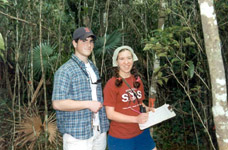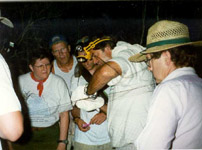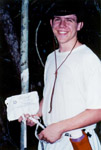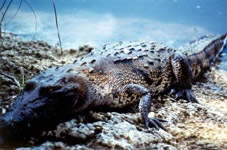HabitatNet: A Global Biodiverrsity Monitoring Project
Field Report Number 5:
El Eden Ecological Reserve Quintana Roo, Mexico
January, 1999
Submitted By: Dan Bisaccio, HabitatNet Project Director
Abstract:
 Further
biological diversity monitoring activities for the 1999 field season
include two HabitatNet field courses. As of this report, one of the
two field courses has been completed (Janaury 14 - 19,1999). The January
field course participants were from Souhegan High School (Amherst,
NH) and the July 10-17, 1999 field course participants includes teachers,
college students (Souhegan High School graduates), and a videographer
who also attended the Janaury, 1999 field course.
Further
biological diversity monitoring activities for the 1999 field season
include two HabitatNet field courses. As of this report, one of the
two field courses has been completed (Janaury 14 - 19,1999). The January
field course participants were from Souhegan High School (Amherst,
NH) and the July 10-17, 1999 field course participants includes teachers,
college students (Souhegan High School graduates), and a videographer
who also attended the Janaury, 1999 field course.
As of this report, thirteen (13) of the twenty-five
(25) quadrats are completed within the hectare biodiversity plot (known
as EEF1). Three additional quadrats (quadrats 13,19,25) are nearing
completion.
Reference Note:
Past HabitatNet Field Reports (Numbers 1,2,3,4) describe
the habitat types, protocols used in this biodiversity monitoring
project, quadrat data, and species accounts. Copies of all reports
are on file at the El Eden Ecological Reserve (Quintana Roo,MX), the
Smithsonian Institute/ Man & Biosphere Program (Washington, D.C.),
and with the Project Director at Souhegan High School (Amherst, NH).
Trip Reports:
14 - 19 Janauary,1999 SHS BioSwat Team
This was the first HabitatNet biodiversity program conducted
during Janaury. Overall, El Eden Ecological Reserve was relatively
wet and green with cool temperatures. Souhegan High School students
("BioSwat Team") conducted SI/MAB measurements in EEF1 during
the five days. Quadrats 12 and 17 were surveyed and mapped (Appendix)
and cumulative data on tree species in all thirteen (13) completed quadrats was calculated.
Additionally, maximum / minimum temperature and humidity data were
collected, as on previous trips, in Quadrat 1 (EEF1) at the "Jaguar
Hut".
data on tree species in all thirteen (13) completed quadrats was calculated.
Additionally, maximum / minimum temperature and humidity data were
collected, as on previous trips, in Quadrat 1 (EEF1) at the "Jaguar
Hut".
Concurrently, species observed, identified, and verified
by the HabitatNet project director were noted and listed in this report.
Additionally, several students conducted independent field projects
with topics including: bat behavior, nature photography, and written
habitat descriptions.
Trip Data:
Janaury 1999
(1) Temperature & Humidity
|
Temperature
|
|
|
Maximum
|
27o C
|
|
|
Minimum
|
25o C
|
|
(2) Canopy Density
Quadrat 12: 90%
Quadrat 17: 90% (evidence of wind thrown trees and early
successional trees)
(3) Species Recorded (Attached)
| Special |
Interest Bird |
Species Observed: |
| Collared Aracari |
Petroglossus torquatus |
(EEF1 Biodiversity
Plot; Q.12) |
| Keel-Billed Toucan |
Ramphastos sulfuratus
|
(2 were observes at
field station) |
| Pygmy Kingfisher |
Chloroceryle aenae
|
(pond by main field
station) |
| OcellatedTurkey |
Agriocharis ocellata
|
(forest) |
| Black Headed Trogon |
Trogon melanocephalus
|
(forest and tintal) |
| Hooded Oriole |
Icterus cucullatus |
(near field station
and tintal) |
| Gray Necked Wood-Rail |
Araimides cajanea
|
(tintal edge/ near
main field station) |
| Ferrugious Pygmy Owl |
Glaucidium brasilianum
|
(tintal / near EESv1)* |
| Yucatan Nightjar |
Caprimulgus badius
|
(forest trail / edge
near EEF1)* |
| American Woodcock |
Scolopax minor
|
(forest trail / edge
near wetlands)* |
* night walks
A total of 35 bird species were observed (checklist
/ field notes attached).
 Concluding
Remarks
Concluding
Remarks
"If the land mechanism as a whole is good, then
every part of it is good, whether we understand it or not. If the
biota, in the course of eons, has built something we like but do not
understand, then who but a fool would discard seemingly useless parts?
To keep every cog and wheel is the first precaution of intelligent
tinkering."
Aldo Leopold: A SAND COUNTY ALMANAC
Certainly, this report is just a beginning. Much more
work needs to be done and will be done over the next several years.
Basic taxonomic work complimented with continuing investigations of
species interactions will allow us to more fully understand and appreciate
the wisdom of Aldo Leopold.
Organismic adaptation and speciation can not keep pace
with the accelerating extinction rate caused by our species ignorance.
In addition to the basic research and investigations afforded by this
project, a primary focus of HabitatNet is to reacquaint students and
teachers with nature so that we may better understand our fundamental
role and responsibility in safeguarding global biological diversity.
The short term goals for 1999 include:
 (1)
Continue quadrat tree surveys in the hectare biodiversity plot known
as EEF1.
(1)
Continue quadrat tree surveys in the hectare biodiversity plot known
as EEF1.
(2) Develop a botanical reference collection at El Eden
(voucher specimens).
(3) Under the auspices of Marco Lazcano-Barrero, develop
a voucher specimen collection of both invertebrate and vertebrates
found within the biodiversity plot.
(4) Fall / Winter 1999: Begin intial interpretation
of quadrat data compiled thus far.
Resources Used in Compiling This Report
Bisaccio, Dan. "Field Report: El Eden Ecological
Reserve: Numbers 1,2,3"
El Eden Website: University of California http://www.ucr.edu/pril/peten/images/el_eden/Home.html
Emmons. Neotropical Rainforest Mammals. University of
Chicago Press: Chicago, IL
Gentry. A Field Guide To The Families and Genera of
Woody Plants of Northwest South America. Conservation International:
Washington, D.C.
Lazcano-Barrero. Marco. Identification of snake species
from discarded skin; April,1998
Lee, Julian. The Amphibians and Reptiles of The Yucatan
Peninsula, Cornell Uiversity Press, 1996
Smithsonian Institute's MAB Digest # 11 , Technical
Report on conducting biodiversity monitoring research. Francisco Dallmeier,
editor.
Smithsonian Institute: MABDATA BioMon Software: DOS
program for managing data compiled at biodiveristy sites; Smithsonian
Institute (SI/MAB), 1992
Will, Tom. "Checklist To Birds of The Yucatan,
Mexico", Gettysburg University, PA1997
Special Notes of Appreciation:
 "HabitatNet"
extends a special thank you to Marco Lazcano-Barrero (Director General;
El Eden Ecological Reserve) and his staff for all of their ongoing
effort and support of this project. ¡Muchas gracias!
"HabitatNet"
extends a special thank you to Marco Lazcano-Barrero (Director General;
El Eden Ecological Reserve) and his staff for all of their ongoing
effort and support of this project. ¡Muchas gracias!
This year we are most fortunate to have Ben Day, videographer,
join our HabitatNet adventures! His talent and genius allow those
who are geographically removed from El Eden Ecological Reserve an
opportunity to experience it visually.
It was my great pleasure to have my colleague and friend,
Susie Carlisle, co-lead the Janaury "BioSwatters". Thank
you Susie for all of your efforts and literary moments!
Finally, it would be impossible to conduct these rapid
biological assessment projects without the intrepid researchers from
Souhegan High School. Their humor, intelligence, and spirit for adventure
gets the job done! Thank you!
| Fredric Boericke |
Courtney Gould |
Amy Verreault |
| Jessica Charpentier |
Sarah Kayser |
Erik White |
| Christy Deysher |
Margaret Lambert |
* Susie Carlisle;
Co-Leader |
| James Fasoli |
Brett Mayes |
* Ben Day; Videographer |
| Lisa Ferrari |
Bonnie Miller |
|
| Emily Ginsberg |
Scott Mohler |
|
Appendix I (Attached)
1. Cumulative Tree Data for all quadrats surveyed thus
far.
2. Quadrat Maps and Surveys completed in 1999.
Appendix II - El Eden Ecological Reserve / HabitatNet
Participants 1999